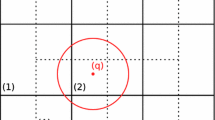Abstract
AnO(n logn) divide-and-conquer algorithm for finding the relative neighborhood graph RNG(V) of a set V ofn points in Euclidean space is presented. If implemented in parallel, its time complexity isO(n) and it requiresO(logn) processors.
Similar content being viewed by others
References
J. L. Bentley and J. H. Friedman,A tree machine for searching problems, Proceedings, IEEE 1979, International Conference on Parallel Computing (1979), pp. 257–266.
M. Blum, R. W. Flody, V. R. Pratt, R. L. Rivest, and R. E. Tarjan,Time bond for selection, Journal of Computer and System Sciences, Vol. 7, No. 4, (1972), pp. 724–742.
R. C. Chang and R. C. T. Lee,An O(N logN)Minimal spanning tree algorithm for N points in the plane, BIT 26 (1986), pp. 7–16.
R. A. Dwyer,A faster divide-and-conquer algorithm for constructing Delaunay triangulations, Algorithmica, Vol. 2, (1987), pp. 137–151.
L. J. Guibas and J. Stolfi,Primitives for the manipulation of general subdivisions and the computation of Voronoi diagrams, ACM Transactions on Graphics 4 (1985), pp. 74–123.
J. W. Jaromczyk and M. Kowaluk,Linear time algorithm to construct the relative neighborhood graph from the Delaunay triangulation in R 2 with the metric L p , Technical report No. 129–88, Department of Computer Science, University of Kentucky, Lexington, KY 40506-0027.
J. Katajainen,The region approach for computing relative neighbourhood graphs in the L p metric, Computing 40 (1988), pp. 147–161.
J. Katajainen and O. Nevalainen,Computing relative neighborhood graphs in the plane, Pattern Recognition, Vol. 19, No. 3, (1986), pp. 221–228.
D. T. Lee,Two-dimensional Voronoi diagrams in the L p metric, Journal of the ACM 27 (1980), pp. 604–618.
D. T. Lee and B. J. Schachter,Two algorithms for constructing Delaunay triangulations, International Journal of Computer and Information Sciences, Vol. 9, No. 3, (1980), pp. 219–242.
K. J. Supowit,The relative neighborhood graph, with an application to minimum spanning trees, Journal of the Association for Computing Machinery, Vol. 30, No. 3, (1983), pp. 428–448.
C. Y. Tang and R. C. T. Lee,Optimal speeding up of parallel algorithms based upon divide-and-conquer strategy, Information Sciences, Vol. 32, No. 3, (1984), pp. 173–186.
G. T. Toussaint,The relative neighborhood graph of a finite planar set, Pattern Recognition, Vol. 12, (1980), pp. 261–268.
Author information
Authors and Affiliations
Rights and permissions
About this article
Cite this article
Huang, NF. A divide-and-conquer algorithm for constructing relative neighborhood graph. BIT 30, 196–206 (1990). https://doi.org/10.1007/BF02017341
Received:
Revised:
Issue Date:
DOI: https://doi.org/10.1007/BF02017341




